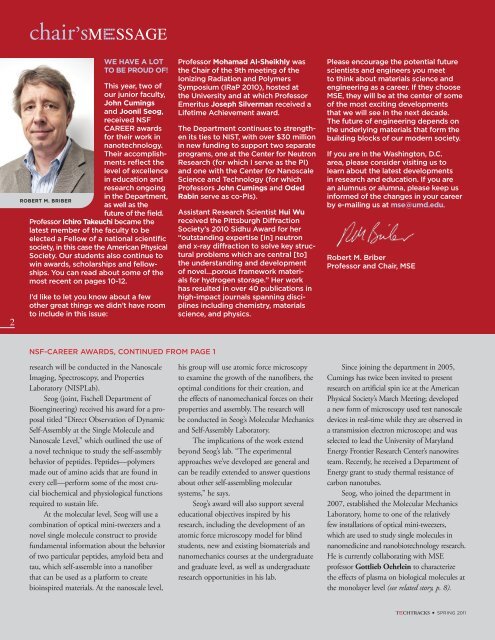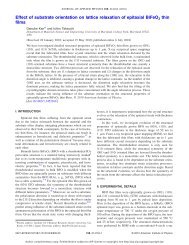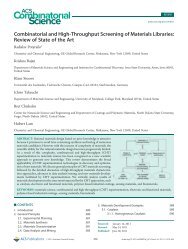Spring 2011 - Materials Science and Engineering - University of ...
Spring 2011 - Materials Science and Engineering - University of ...
Spring 2011 - Materials Science and Engineering - University of ...
Create successful ePaper yourself
Turn your PDF publications into a flip-book with our unique Google optimized e-Paper software.
chair’sMESSAGE<br />
2<br />
ROBERT M. BRIBER<br />
We have a lot<br />
to be proud <strong>of</strong>!<br />
This year, two <strong>of</strong><br />
our junior faculty,<br />
John Cumings<br />
<strong>and</strong> Joonil Seog,<br />
received NSF<br />
CAREER awards<br />
for their work in<br />
nanotechnology.<br />
Their accomplishments<br />
reflect the<br />
level <strong>of</strong> excellence<br />
in education <strong>and</strong><br />
research ongoing<br />
in the Department,<br />
as well as the<br />
future <strong>of</strong> the field.<br />
Pr<strong>of</strong>essor Ichiro Takeuchi became the<br />
latest member <strong>of</strong> the faculty to be<br />
elected a Fellow <strong>of</strong> a national scientific<br />
society, in this case the American Physical<br />
Society. Our students also continue to<br />
win awards, scholarships <strong>and</strong> fellowships.<br />
You can read about some <strong>of</strong> the<br />
most recent on pages 10-12.<br />
I’d like to let you know about a few<br />
other great things we didn’t have room<br />
to include in this issue:<br />
Pr<strong>of</strong>essor Mohamad Al-Sheikhly was<br />
the Chair <strong>of</strong> the 9th meeting <strong>of</strong> the<br />
Ionizing Radiation <strong>and</strong> Polymers<br />
Symposium (IRaP 2010), hosted at<br />
the <strong>University</strong> <strong>and</strong> at which Pr<strong>of</strong>essor<br />
Emeritus Joseph Silverman received a<br />
Lifetime Achievement award.<br />
The Department continues to strengthen<br />
its ties to NIST, with over $30 million<br />
in new funding to support two separate<br />
programs, one at the Center for Neutron<br />
Research (for which I serve as the PI)<br />
<strong>and</strong> one with the Center for Nanoscale<br />
<strong>Science</strong> <strong>and</strong> Technology (for which<br />
Pr<strong>of</strong>essors John Cumings <strong>and</strong> Oded<br />
Rabin serve as co-PIs).<br />
Assistant Research Scientist Hui Wu<br />
received the Pittsburgh Diffraction<br />
Society’s 2010 Sidhu Award for her<br />
“outst<strong>and</strong>ing expertise [in] neutron<br />
<strong>and</strong> x-ray diffraction to solve key structural<br />
problems which are central [to]<br />
the underst<strong>and</strong>ing <strong>and</strong> development<br />
<strong>of</strong> novel…porous framework materials<br />
for hydrogen storage.” Her work<br />
has resulted in over 40 publications in<br />
high-impact journals spanning disciplines<br />
including chemistry, materials<br />
science, <strong>and</strong> physics.<br />
Please encourage the potential future<br />
scientists <strong>and</strong> engineers you meet<br />
to think about materials science <strong>and</strong><br />
engineering as a career. If they choose<br />
MSE, they will be at the center <strong>of</strong> some<br />
<strong>of</strong> the most exciting developments<br />
that we will see in the next decade.<br />
The future <strong>of</strong> engineering depends on<br />
the underlying materials that form the<br />
building blocks <strong>of</strong> our modern society.<br />
If you are in the Washington, D.C.<br />
area, please consider visiting us to<br />
learn about the latest developments<br />
in research <strong>and</strong> education. If you are<br />
an alumnus or alumna, please keep us<br />
informed <strong>of</strong> the changes in your career<br />
by e-mailing us at mse@umd.edu.<br />
Robert M. Briber<br />
Pr<strong>of</strong>essor <strong>and</strong> Chair, MSE<br />
NSF-CAREER Awards, continued from page 1<br />
research will be conducted in the Nanoscale<br />
Imaging, Spectroscopy, <strong>and</strong> Properties<br />
Laboratory (NISPLab).<br />
Seog (joint, Fischell Department <strong>of</strong><br />
Bioengineering) received his award for a proposal<br />
titled “Direct Observation <strong>of</strong> Dynamic<br />
Self-Assembly at the Single Molecule <strong>and</strong><br />
Nanoscale Level,” which outlined the use <strong>of</strong><br />
a novel technique to study the self-assembly<br />
behavior <strong>of</strong> peptides. Peptides—polymers<br />
made out <strong>of</strong> amino acids that are found in<br />
every cell—perform some <strong>of</strong> the most crucial<br />
biochemical <strong>and</strong> physiological functions<br />
required to sustain life.<br />
At the molecular level, Seog will use a<br />
combination <strong>of</strong> optical mini-tweezers <strong>and</strong> a<br />
novel single molecule construct to provide<br />
fundamental information about the behavior<br />
<strong>of</strong> two particular peptides, amyloid beta <strong>and</strong><br />
tau, which self-assemble into a nan<strong>of</strong>iber<br />
that can be used as a platform to create<br />
bioinspired materials. At the nanoscale level,<br />
his group will use atomic force microscopy<br />
to examine the growth <strong>of</strong> the nan<strong>of</strong>ibers, the<br />
optimal conditions for their creation, <strong>and</strong><br />
the effects <strong>of</strong> nanomechanical forces on their<br />
properties <strong>and</strong> assembly. The research will<br />
be conducted in Seog’s Molecular Mechanics<br />
<strong>and</strong> Self-Assembly Laboratory.<br />
The implications <strong>of</strong> the work extend<br />
beyond Seog’s lab. “The experimental<br />
approaches we’ve developed are general <strong>and</strong><br />
can be readily extended to answer questions<br />
about other self-assembling molecular<br />
systems,” he says.<br />
Seog’s award will also support several<br />
educational objectives inspired by his<br />
research, including the development <strong>of</strong> an<br />
atomic force microscopy model for blind<br />
students, new <strong>and</strong> existing biomaterials <strong>and</strong><br />
nanomechanics courses at the undergraduate<br />
<strong>and</strong> graduate level, as well as undergraduate<br />
research opportunities in his lab.<br />
Since joining the department in 2005,<br />
Cumings has twice been invited to present<br />
research on artificial spin ice at the American<br />
Physical Society’s March Meeting; developed<br />
a new form <strong>of</strong> microscopy used test nanoscale<br />
devices in real-time while they are observed in<br />
a transmission electron microscope; <strong>and</strong> was<br />
selected to lead the <strong>University</strong> <strong>of</strong> Maryl<strong>and</strong><br />
Energy Frontier Research Center’s nanowires<br />
team. Recently, he received a Department <strong>of</strong><br />
Energy grant to study thermal resistance <strong>of</strong><br />
carbon nanotubes.<br />
Seog, who joined the department in<br />
2007, established the Molecular Mechanics<br />
Laboratory, home to one <strong>of</strong> the relatively<br />
few installations <strong>of</strong> optical mini-tweezers,<br />
which are used to study single molecules in<br />
nanomedicine <strong>and</strong> nanobiotechnology research.<br />
He is currently collaborating with MSE<br />
pr<strong>of</strong>essor Gottlieb Oehrlein to characterize<br />
the effects <strong>of</strong> plasma on biological molecules at<br />
the monolayer level (see related story, p. 8).<br />
TECHTRACKS <strong>Spring</strong> <strong>2011</strong>












